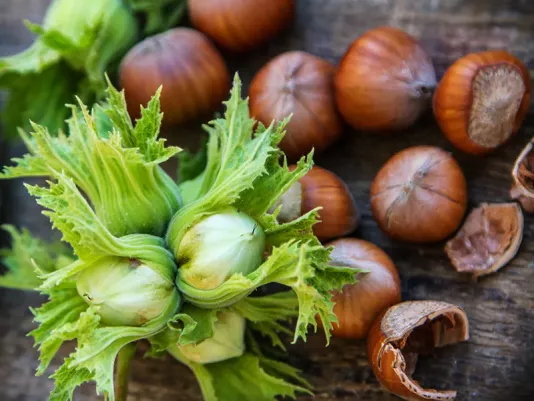Banana Muffin
Banana muffin - a fluffy American banana cake recipe with nuts.

Hazelnut has an ancient culinary history, and over the years I’ve learned to recognize the best nuts by their scent and color. Ripe kernels have an even tone without spots and a scent of damp wood. When I first started working with it, I didn’t always understand how much quality affected the result: old or poorly dried nuts can ruin even the most perfect dough. Now I always choose fresh hazelnuts in their shells, store them in a cool, dry place, and gently warm them before use to restore their aroma. That’s when they reveal their true flavor – soft, buttery, and nutty, beautifully enhancing both sweet and savory dishes.
Over years of cooking, I’ve learned that the best hazelnuts are those with intact shells – no cracks or dark spots. The shell should be dry, slightly rough to the touch, with no signs of mold. I always shake the nut – the sound inside should be dull and quiet, which indicates the kernel’s freshness. If you buy shelled hazelnuts, look for an even color and a natural surface sheen. I store the kernels in a tightly sealed glass jar in a dark place, away from spices, since they easily absorb odors. In the refrigerator, hazelnuts stay fresh for several months, and in the freezer – up to a year. It’s important to avoid moisture: even a small amount causes bitterness. In my practice, I always take the nuts out of the cold in advance so they reach room temperature before grinding. This helps prevent condensation and aroma loss. Hazelnuts harvested in autumn are especially flavorful – they contain more natural oil, which gives dishes depth and richness.
To unlock the aroma of hazelnuts, they should be lightly roasted. I do this in a dry skillet, stirring constantly until the kernels turn golden and give off a scent of baked bread. Then I transfer the hot nuts into a towel and rub them well to remove the thin skin. It comes off easily if the nuts aren’t over-roasted. I once tried doing this in the oven but noticed that at too high a temperature the kernels darken quickly and lose their tenderness. Now I only use medium heat – it allows more precise control. If you need to prepare a large batch, you can pour boiling water with baking soda over the kernels for a minute, then cool them – the skin will come off more easily, but they must be dried thoroughly afterward. Peeled hazelnuts can be ground or chopped, but I always do this in small portions to prevent them from turning into a paste. Proper preparation is half the success in recipes where texture matters – from sponge cakes to sauces.
Temperature control is the key to the perfect hazelnut flavor. I’ve learned many times that even a few degrees can change the result. For even roasting, 160°C (320°F) in the oven for about 10-12 minutes is enough. At lower temperatures, the kernels remain moist; at higher ones, they risk burning and becoming bitter. In a skillet, the process is faster but requires constant stirring. When I prepare nuts for creams, I leave them slightly under-roasted to keep their softness and creamy flavor. For salads or sauces, I roast them longer to achieve a rich aroma and crispness. It’s important to cool the nuts immediately after heating – I spread them in a thin layer on a cold tray. If left hot in a pile, they continue to cook from their own heat. Proper temperature determines not only texture but also the level of aromatic oils: overheated hazelnuts quickly lose their natural notes, while overcooled ones can become limp and flavorless.
Hazelnuts have a unique aromatic profile – warm, slightly sweet, with a hint of creamy caramel. In my practice, I often pair them with dark chocolate, honey, citrus, or berries, but they are equally delightful in savory dishes. For example, finely chopped hazelnuts beautifully complement poultry or fish, adding depth and mild sweetness. In sauces, they can be blended with olive oil, garlic, and herbs – creating something like a delicate pesto but with warmer notes. Over the years I’ve learned that the secret of balance lies in contrast: if a dish is rich in fats, the nuts should be lightly roasted; if it’s more acidic, then it’s better to use deeply roasted kernels. In desserts, I always reduce sugar slightly when adding hazelnuts, as their natural sweetness already provides harmony. To enhance the aroma, I sometimes mix crushed kernels with a pinch of sea salt – it wonderfully brings out the nutty depth.
The most common mistake is over-roasting. Hazelnuts react quickly to heat, and even a few seconds can turn their delicate flavor bitter. I always watch the color: when it turns light golden, I remove them from the heat immediately. Another issue is improper grinding. If done too long, the kernels release oil and turn into a paste, so I work in short pulses. Moisture should also be avoided – it ruins the structure. In my practice, I never use old nuts, even for baking: a musty smell or dark spots indicate spoilage. To check quality, I bite one kernel – the taste should be clean, without bitterness. If hazelnuts have become slightly stale, they can be refreshed in the oven over low heat, but for no more than a few minutes. These may seem like small details, but it’s precisely this attention to them that ensures hazelnuts retain their natural beauty, aroma, and benefits in any dish.